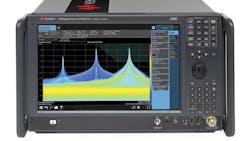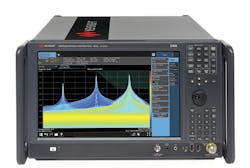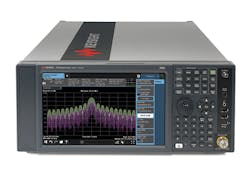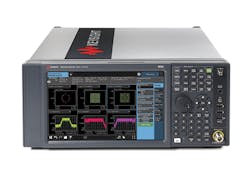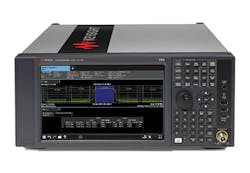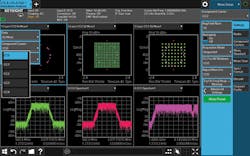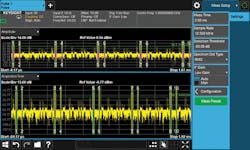New-Look Analyzers Scour Bandwidths from 3 Hz to 50 GHz
This file type includes high-resolution graphics and schematics when applicable.
Bandwidth is a precious commodity, with an increasing amount of applications, from commercial automotive safety systems to military radar systems, occupying RF and microwave bands. Keeping all of those signals straight can be a chore, but the job just got easier with the latest generation of X-Series signal analyzers from Keysight Technologies.
These versatile instruments feature improved performance levels compared to the previous-generation analyzers, complemented by a new look with easy-to-use touchscreens that can speed and simplify the capture and analysis of the most troublesome signals. Five different analyzer configurations provide frequency coverage from 3 Hz to 50 GHz, with frequency extensions available.
Signal analysis is becoming more critical, as new wireless applications continue to compete for bandwidth availability and, perhaps more importantly, pose potential problems for existing applications. Government organizations like the Federal Communications Commission (FCC) may strive to separate different wireless applications according to carefully chosen frequency allocations. However, these organizations cannot control such variables as second and third harmonics and spurious signal content, which can turn any lower-frequency wireless application into interference for higher-frequency applications.
To properly monitor and measure any segment of spectrum, signal analyzers with the desired frequency range and low instrument noise levels, high sensitivity, and wide analysis bandwidths make it possible to capture and display all signals present over a frequency range—even intermittent signals and those close to the noise level. The new X-Series signal analyzers offer that measurement capability with an intuitive user interface and easy-to-read display screens.
High Performance with a Touch
The latest X-Series analyzers include several instruments with similar measurement functions and user interfaces, differentiated by frequency ranges and various performance levels, such as analysis bandwidths and real-time bandwidths. The instruments represent a leap forward in performance and operating ease, with 14.1- or 10.6-in. multi-touch capacitive display screens. Anyone with a touchscreen laptop computer will quickly grasp the ability to move measurement points on a screen with a finger, and compress and shift waveforms by simply gesturing with two fingers along the screen.
With enhancements in phase noise, bandwidth, and real-time streaming capacity that supersede the previous X-Series analyzers, these new instruments offer a common user interface and provide users with as much or as little performance (and corresponding price) as needed for an application. The beauty of the common user interface is that, even when a facility may invest in several different X-Series models (e.g., one for video testing and one for pulse testing), a user learning to operate one model will already know how to operate the other model.
Any choice of instrument model need not mean a commitment to final performance levels, since frequency ranges and performance can be upgraded at any time. The firm even provides liberal trade-in offers for owners of previous-generation X-Series signal analyzers, enabling them to upgrade to the latest generation. In addition, the instruments are backed by a strong library of test software programs that can tailor each instrument for specific measurement applications, from commercial communications to military pulsed radar testing.
Promising Performance
Of course, such ease of use is meaningless without performance, and the new X-Series signal analyzers, provide a wide selection of frequency ranges and performance levels. The X-Series actually comprises five models, with each model—the UXA, PXA, MXA, EXA, and CXA—featuring a number of different frequency-range options (see table):
UXA: The top-of-the-line UXA X-Series signal analyzer (Fig. 1), covers bandwidths of 3 Hz to 8.4, 13.6, 26.5, 44.0, or 50.0 GHz (and as high as 1.1 THz with external mixing) with a standard analysis bandwidth of 25 MHz. The analysis bandwidth can be extended to 40, 255, 510, and 1000 MHz as an option. It also provides true fast Fourier transform (FFT) real-time analysis bandwidths as wide a 510 MHz for capture and analysis of the most elusive signals.
Real-time spectrum-analysis capability makes it possible to capture and view signals as short as 3.517 µs with 100% probability of intercept (POI) and spurious-free dynamic range (SFDR) of 78 dBc across a 510-MHz bandwidth. Real-time streaming can be performed across bandwidths as wide as 255 MHz with 16-b resolution at 300 Msamples/s for gap-free recording, ensuring capture of the most elusive, nonrecurring signals.
The UXA analyzers maintain a displayed average noise level (DANL) of –171 dBm at 2 GHz with preamplifier and Noise Floor Extension function turned on. The phase noise is –136 dBc/Hz offset 10 kHz from a 1-GHz carrier and –126 dBc/Hz offset 10 kHz from a 10-GHz carrier. The analyzers achieve amplitude accuracy of ±0.16 dB and third-order intermodulation (TOI) distortion of +23 dBm.
PXA: Down just a notch in performance (and price), the PXA analyzers offer similar frequency coverage as the UXA instruments, with slightly less amplitude accuracy and without the choice of a wide 1-GHz analysis bandwidth. The PXA (Fig. 2) covers frequency ranges of 3 Hz to 3.6, 8.4, 13.6, 26.5, 44.0, or 50.0 GHz (and as high as 1.1 THz with external mixing) with a standard analysis bandwidth of 25 MHz. Options exist for analysis bandwidths of 40, 85, 160, 255, and 510 MHz. As with the UXA instruments, DANL is –171 dBm at 2 GHz with preamplifier and Noise Floor Extension function turned on. With real-time bandwidths to 510 MHz, the PXA analyzers can show signals as short as 3.517 µs with 100% POI.
The full amplitude accuracy for the PXA analyzers is slightly less than that of the UXA at ±0.19 dB. They have phase noise of –132 dBc/Hz offset 10 kHz from a 1-GHz carrier and the UXA, PXA, MXA, EXA, and CXA 124 dBc/Hz offset 10 kHz. The TOI distortion is +23 dBm and the SFDR is –75 dBc for a 160-MHz bandwidth. As with the UXA instruments, the PXA analyzers offer gap-free streaming to 255 MHz for real-time analysis.
MXA: In the middle of the “X-Series pack,” the MXA signal analyzer (Fig. 3). It includes a choice of frequency ranges from 10 Hz to 3.6, 8.4, 13.6, or 26.5 GHz (and as high as 1.1 THz with external mixing) with standard analysis bandwidth of 25 MHz and options for analysis bandwidths of 40, 85, 125, and 160 MHz. As with the two higher-performance X-Series analyzers, the MXA supports real-time bandwidths to 160 MHz and can capture signals as short as 3.517 µs with 100% POI and SFDR of 72 dBc across a 160-MHz bandwidth.
The MXA achieves a DANL of –171 dBm at 2 GHz with preamplifier and Noise Floor Extension function turned on, and amplitude accuracy of ±0.23 dB. TOI distortion is +19 dBm, while the phase noise is –114 dBc/Hz offset 10 kHz from a 1-GHz carrier and –108 dBc/Hz offset 10 kHz from a 10-GHz carrier. These analyzers are well-suited for wireless standards testing, and feature a wideband code-division-multiple-access (WCDMA) adjacent-channel-power (ACP) dynamic range of typically 73 dBc and up to 78 dBc with noise correction.
EXA: For those in search of cost-effective signal analysis through millimeter-wave frequencies, the EXA X-Series signal analyzer, despite lacking the real-time analysis capabilities of the top three models, packs a great deal of measurement power that covers frequencies from 10 Hz to 3.6, 7.0, 13.6, 26.5, 32.0, or 44.0 GHz (and as high as 1.1 THz with external mixing). It features a standard analysis bandwidth of 25 MHz and offers an option for an analysis bandwidth of 40 MHz.
For the value-minded, the EXA still delivers on performance, with amplitude accuracy of ±0.27 dB and phase noise of –109 dBc/Hz offset 10 kHz from a 1-GHz carrier and –102 dBc/Hz offset 10 kHz from a 10-GHz carrier. DANL is –171 dBm at 2 GHz with a preamplifier and noise floor extension function turned on, while the TOI distortion is +19 dBm at 2 GHz. Also handy for wireless standards testing, the EXA analyzers offer a 68-dBc WCDMA ACP dynamic range (and 73 dBc with noise correction).
CXA: The lowest-cost members the new X-Series, the CXA analyzers (Fig. 4), provide a standard analysis bandwidth of 10 MHz with an option for 25 MHz, along with options covering frequency ranges of 9 kHz to 3.0, 7.5, 13.6, and 26.5 GHz. These analyzers also lack the real-time bandwidth capabilities of the top three models, but still boast impressive performance value, with amplitude accuracy of ±0.50 dB and phase noise of –110 dBc/Hz offset 10 kHz from a 1-GHz carrier. DANL is –163 dBm at 2 GHz with a preamplifier and Noise Floor Extension function turned on, while the TOI distortion is +17 dBm. The standard WCDMA ACP dynamic range is 66 dBc and as good as 73 dBc with noise correction.
Don’t Forget the Software
To help harness all that power, an extensive library of software measurement programs provide all of the essential measurements for a wide range of in-demand applications, including cellular communications, phase-noise measurements, and pulsed radar system testing. The software covers the latest conformance and standards-based measurements, including WCDMA signals as well as Long Term Evolution (LTE) and LTE Advanced (LTE-A) frequency-division-duplex (FDD) and time-division-duplex (TDD) signals. There’s also support for 256-state quadrature-amplitude-modulation (256QAM) testing. LTE/LTE-A software, for example, dubbed N9080C (for FDD measurements) and N9082C (for TDD measurements), covers all new X-Series signal analyzers (Fig. 5).
Additional software tools, including X-Series measurement applications and 89600 vector-signal-analysis (VSA) software, offer analyzer control for specific wireless standards, such as GSM, cdma2000, Bluetooth, and WiMAX, as well as for general-purpose pulsed, noise-figure, and phase-noise measurements. All feature transportable licensing between different X-Series signal analyzers.
The phase-noise measurement application (model N9068C) supports external mixing for measurements to 110 GHz with Keysight smart harmonic mixers. It also takes advantage of the analyzers’ flexible display screens to show phase noise in traditional logarithmic plots as well as phase-noise values for spot frequencies. Furthermore, it provides useful phase-based parameters, such as root-mean-square (RMS) phase deviations, RMS phase jitter, and residual frequency modulation (FM).
The pulse measurement application (model N9067C), as with the other X-Series measurement applications, supports transportable licensing between different X-Series signal analyzers. The pulse software (Fig. 6) can provide parameters on as many as 1000 continuous pulses, displaying such results as pulse width, average power, peak power, rise/fall time, pulse repetition interval (PRI), and pulse repetition frequency (PRF).
In short, the analyzers provide enormous raw measurement power with operator interfaces that help tap into the measurement power with a short learning curve. With the multi-touch screens, many users will be drawn to developing their own test programs that take advantage of the analyzers’ high-performance levels.
But for those who want a ready-made solution, a long list of test software tools has already been developed, for everything from general-purpose measurements to specific tests for cellular communications and wireless-connectivity standards. The measurement power, ease of use, and existing knowledge base make an unbeatable combination for anyone seeking signal-analysis solutions through millimeter-wave frequencies. P&A: $13,284 (3-GHz CXA) to $115,743 (50-GHz UXA).
Keysight Technologies Inc., 1400 Fountaingrove Pkwy., Santa Rosa, CA 95403; (707) 577-2663
About the Author
Jack Browne
Technical Contributor
Jack Browne, Technical Contributor, has worked in technical publishing for over 30 years. He managed the content and production of three technical journals while at the American Institute of Physics, including Medical Physics and the Journal of Vacuum Science & Technology. He has been a Publisher and Editor for Penton Media, started the firm’s Wireless Symposium & Exhibition trade show in 1993, and currently serves as Technical Contributor for that company's Microwaves & RF magazine. Browne, who holds a BS in Mathematics from City College of New York and BA degrees in English and Philosophy from Fordham University, is a member of the IEEE.
